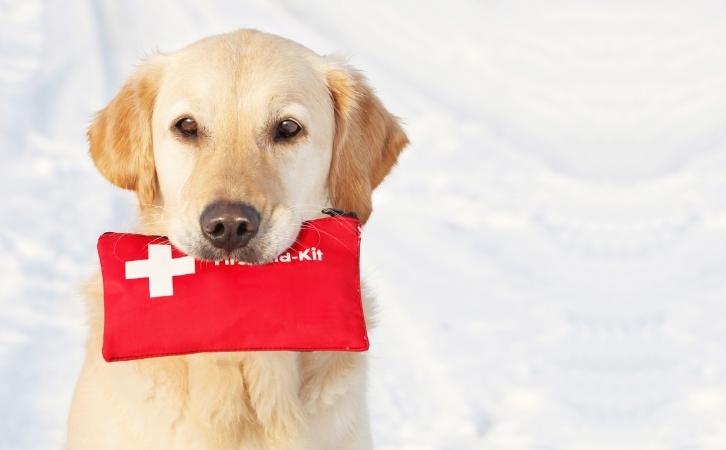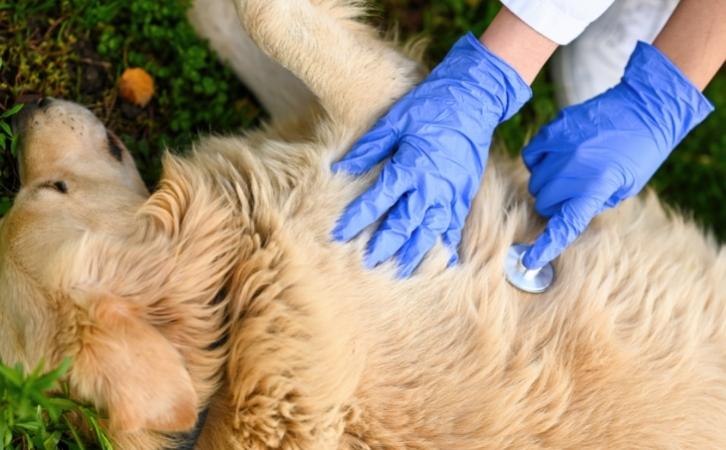Pet first aid and emergency therapy may be helpful if your pet gets injuries or other medical situations. It could save your pet’s life. So, Make sure you have a pet first aid kit with all essential pieces of equipment. This blog is all about what you should know about pet first aid.
Read Here: How to Choose the Right Toys for Your Dog
Table of Contents
What does it mean to provide first aid to animals?
Animal first aid is care given to a domestic animal in an emergency before a licensed veterinarian can treat it. While a veterinarian must perform some medical operations, untrained individuals can provide first aid to stabilize an animal and make it more comfortable until a veterinarian can treat it.
What should I do first in an emergency?
- Remain calm and examine the situation for any other hazards to you or your pet. This is critical for everyone’s security.
- Keep your dog as warm as possible (unless in the case of heatstroke) and as quiet as possible, especially if there is any possibility of injuries, broken limbs, or neurological signs.
- Contact your local veterinary facility, explain the incident, and seek precise first-aid instructions.
- If you need to move an injured dog, carefully place your dog on a blanket or coat and gently transport him to the carrier, crate, or stretcher.
- As soon as possible, get to a veterinary hospital.
Read Here: Can dogs eat jaggery?
A First Aid Kit for Pets

A pet first aid kit makes administering first aid to pets possible and much easier. Having a pet first aid kit available could be the difference between life and death if you own a pet, even in less severe circumstances. Being how to provide first aid to your pet will make them feel more at ease and speed up their recovery.
Read Here: shih tzu price in india
1. Emergency Contact Information Card
Write down the phone numbers of your veterinarian, a 24-hour emergency clinic, and animal poison control on a contact card. A duplicate of the card can be left with a sitter if you have to go with your pet. A copy should be kept in your wallet as well.
2. Scissors with a blunt tip
A pair of scissors may be forgotten in a pet first aid kit, but administering care might be difficult without them. Scissors come in handy for removing hair from around an injury or applying bandages. When clipping hair near the eyes, nose, or ears, this is very crucial.
Read Here: Red Dog Breeds That Turn Heads in India
3. Bandages

Bandages are a must-have in any dog or cat first-aid kit. The bandage you use after an accident is often only temporary until you can see your veterinarian. Nonetheless, it plays an essential function in offering assistance and preventing contamination. Ensure the bandages are secure enough not to fall off but not so tight that blood flow is harmed.
Read Here: Best Dog Breeds for First-Time Owners in India
4. Eye Sterile Solution
It’s frightening to consider chemicals or similar items near your pet’s eyes. If an irritation gets into the eye, the animal will scratch or rub it, aggravating it. Consult your veterinarian before attempting any therapy because eye injuries can be severe.
5. Gloves made of latex or rubber
Gloves are essential equipment while delivering first aid to pets. In addition, to protect yourself, wearing gloves reduces the danger of infection for your pet. It’s very easy to contaminate an animal’s wound inadvertently. Consider including several pairs of gloves in your bag. One pair may rip, or you may require assistance from another individual.
6. Syringe

Anyone who has tried to give a fidgety pet liquid-based oral pet medications understands the need for a syringe. You can also use a needleless syringe to deliver oral fluids to a dehydrated pet or wash out and disinfect a wound. Ensure that your syringe is sealed and clean until you require it.
7. Medication
You may need to have specific medications (including prescription meds) in your first aid kit for dogs depending on your dog or cat’s needs. But make sure you keep an eye on the expiration dates. In addition to any prescription meds, it’s a good idea to have a few common cures on hand.
8. Tweezers
When a sharp object, such as a thorn or shard of glass, becomes lodged in a pet’s skin, removing it with your fingers can be difficult. Tweezers are the more convenient, safer, and sanitary option. It may also be required for tick eradication. It makes it much easier to remove a tick by allowing you to grab it as close to your pet’s skin as possible.
9. Antiseptic Wipes
Antiseptic wipes or rinses can help reduce the chance of infection in your pet’s wound. Wipes are particularly useful for cleaning around the mouth and in between the toes.
10. Thermometer
Your pet’s temperature might help you determine how bad their condition is. It will also be helpful information to share while speaking with your veterinarian over the phone. Using a thermometer is very easy. Apply a petroleum or water-based lubricant on the thermometer’s end for stress-free insertion.
Allow someone to gently detain and distract your pet while you lift the tail only as necessary to put the thermometer’s metal tip into your pet’s rectum (approximately one-half inch). Ensure you get a thermometer that can read temperatures up to 105 degrees Fahrenheit.
How to deal with some medical emergencies?
1. Bone fractures
Prevent further injuries by stopping the animal from fleeing. A boot cover can be used as a secure homemade stretcher while driving. A swollen or deformed limb could indicate a fracture or broken bone. The animal may be limping or not moving at all because of its reduced mobility.
Make arrangements to take your pet to the veterinarian. Keep them warm by placing them in a box padded with blankets. Cover the damaged area with blankets to keep them warm to the veterinarian. A broken or cracked bone should not be bandaged or splinted.
2. Toxic poisoning
Don’t do mouth-to-snout resuscitation if you fear your pet has taken poison since you could become infected. Call the doctor as soon as possible. If the clinic is nearby, drive to the place.
3. Vomiting

If your pet is sick, bring a sample to the clinic with you. It will help them identify any poisons and treat your pet more successfully. Vomiting is common in pets and isn’t always a symptom of a severe problem. If the vomit contains blood or the animal continues to vomit, you should take your pet to the veterinarian for a check-up.
4. Burn injuries
If your pet has burns, cool the area with water for at least 10 minutes before applying bandages that may become glued to the wound. Apply cold water to the burn area instead of ice or ice water.
This can be accomplished by using a showerhead. Call your veterinarian before cleaning the animal with water and follow their instructions. Do not use ointment or cream unless your veterinarian has prescribed it. Keep your pet warm with a blanket while you attend to a burn.
5. Bleeding Claws and ears

If you mistakenly snip a pet’s claw too far up and it starts to bleed, cover it with an absorbent treatment and wrap it up the leg as possible to keep it from slipping down. Seek veterinary help if the bleeding does not cease within a reasonable time. It may assist in binding the ear downwards with a bandage until you can seek help for bleeding ears, primarily if the pet has upwards pointing ears.
6. Animal CPR
If CPR is required, the pet should be placed on its right side, as their hearts are somewhat to the left.
A modest upwards tilt of their head (but not too far) will prevent their tongue from blocking their airway. Start with five breaths — with small animals; you may be able to cover their snout with your mouth; for larger animals, keep your tongue outside of your mouth and breathe into their nose. Switch from 15 compressions to two breaths after the first five. Make sure you’re not inhaling too much air, just enough to feel their chest lift.
7. Choking or difficulty breathing
If an animal is choking, leave it alone; if they can cough, they can still breathe; animals are very good at clearing their airways; you should only help if the animal stops choking and goes limp or comatose.
Open the animal’s mouth and sweep your finger inside to remove any objects. Examine the interior to determine if anything can be removed. If you try to reach something down their throat with your fingers, you risk pushing it deeper down. When something is slick and tough to remove with your fingers, tweezers come in handy.
Virtual Pet First Aid Workshop
reference
What You Need to Know About Pet First Aid


